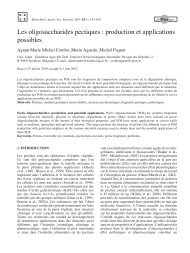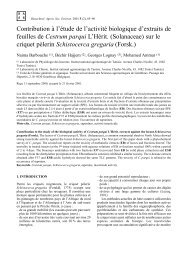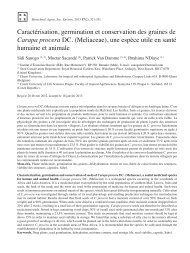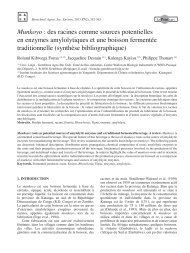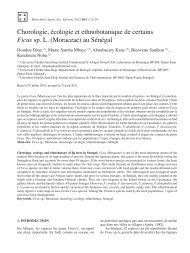Culture of Spirogyra africana from farm ponds for long- term ...
Culture of Spirogyra africana from farm ponds for long- term ...
Culture of Spirogyra africana from farm ponds for long- term ...
You also want an ePaper? Increase the reach of your titles
YUMPU automatically turns print PDFs into web optimized ePapers that Google loves.
424 Biotechnol. Agron. Soc. Environ. 2013 17(3), 423-430 Gallego I., Casas J.J., Fuentes-Rodriguez F. et al.case <strong>of</strong> Andalusian <strong>farm</strong> <strong>ponds</strong>, S. <strong>africana</strong> is one <strong>of</strong> themost common growing macroalgae, which may <strong>for</strong>msmonoalgal mats during spring months (I. Gallego,unpubl. data).The genus <strong>Spirogyra</strong> has recently drawn attentionto researchers due to its various biotechnological andindustrial applications, mostly based on its sorptionproperties. <strong>Spirogyra</strong> filaments remove heavy metals(Romera et al., 2007; Singh et al., 2007; Kaonga et al.,2008; Pribyl et al., 2008) and other toxic compounds<strong>from</strong> effluents (Aleissa et al., 2004; Çelekli et al.,2009); as well as they produce allelochemicalsinhibiting microalgal growth (Zakaria, 2002; Trochineet al., 2011), implying important consequences <strong>for</strong>the management <strong>of</strong> aquatic ecosystems. Antiviraland antihelmintic properties have also been reported(Muller-Feuga et al., 2003; Pultz et al., 2004). Morerecently, <strong>Spirogyra</strong> biomass has been shown to bean efficient energy source <strong>for</strong> bi<strong>of</strong>uel (Hossain et al.,2008; Eshaq et al., 2010; John et al., 2011).Both stock maintenance and growth <strong>of</strong> algal speciesare essential <strong>for</strong> their use in biotechnology. There<strong>for</strong>e,the search <strong>of</strong> the most suitable culture media and ease<strong>of</strong> laboratory culture are relevant topics. Regardinggenus <strong>Spirogyra</strong>, culture techniques were firstreported early in the 20 th century (see Kadlubowska,1984 and references herein). Mainly three culturemedia have proved successful <strong>for</strong> <strong>Spirogyra</strong> growthunder laboratory conditions in short-<strong>term</strong> culture:sD11 (Graham et al., 1995), Half-Strength CHU#10(Nalewajko et al., 1989), and Artificial Pond Water(Inoue et al., 2002). However, their suitability <strong>for</strong> <strong>long</strong><strong>term</strong>experiments has not been tested so far, neithercontrasting experiments on different culturing mediahave not been carried out under the same environmentalconditions (e.g. irradiance, temperature).One <strong>of</strong> the most widely used media <strong>for</strong> <strong>Spirogyra</strong>cultures nowadays is water <strong>from</strong> the source ecosystem,e.g. Townsend et al. (2008), sometimes replaced byArtificial Pond Water (Inoue et al., 2002; Ikegaya et al.,2004; Yoshida et al., 2009). sD11 culture medium hasalso proved suitable <strong>for</strong> <strong>Spirogyra</strong> culturing (Nalewajkoet al., 1989). It is derived <strong>from</strong> D11 medium, originallyused <strong>for</strong> Cladophora Kützing (1843) and slightlymodified <strong>for</strong> <strong>Spirogyra</strong> (Graham et al., 1995; O’Nealet al., 1995). Half-Strength CHU#10, hence<strong>for</strong>thHSCHU#10, has been widely used <strong>for</strong> a variety <strong>of</strong>green alga, including <strong>Spirogyra</strong> spp. (Saygideger,1996).The presence <strong>of</strong> epibionts in <strong>Spirogyra</strong> in vitrocultures is one <strong>of</strong> the major problems in testing filamentsgrowth, despite the continuous mucilage secretion <strong>from</strong><strong>Spirogyra</strong> cell walls (Simons et al., 1990; Wöber et al.,2007). Among the several techniques used to removeepibionts <strong>from</strong> macroalgae, chlorination – an oxidantsterilization <strong>of</strong> filaments with a sodium hypochloritesolution – has been successful <strong>for</strong> epiphytic algae inseawater (Pang et al., 2007) and is commonly used <strong>for</strong>obtaining axenic cultures, e.g. García-Jiménez et al.(1999). To our knowledge, no evidence has been found<strong>for</strong> its use in <strong>Spirogyra</strong> cultures.Rhizoid production has also been included as aparameter <strong>for</strong> quantifying filament growth and survival,since rhizoids fix the filaments to the substratum andhence facilitate algal survival. Several factors havebeen reported as drivers <strong>of</strong> rhizoid genesis, such assubstratum properties (Ikegaya et al., 2008) or thelowering <strong>of</strong> extracellular Ca 2+ concentration (Inoueet al., 2002; Yamada et al., 2003). Release <strong>of</strong> singlecells resulting <strong>from</strong> filament-severing (Inoue et al.,2002; Ikegaya et al., 2008) has also been reported as atriggering factor.In the present study, we measured growth rate,percentage <strong>of</strong> live filaments and rhizoid production <strong>of</strong><strong>Spirogyra</strong> <strong>africana</strong> filaments over 10 weeks in threecommonly-used culture media – sD11, HSCHU#10and Filtered Pond Water (FPW) i.e. water <strong>from</strong> thesource pond where the filaments were gathered – withthe aim <strong>of</strong> culturing <strong>Spirogyra</strong> <strong>africana</strong> <strong>for</strong> <strong>long</strong><strong>term</strong>maintenance, thus facilitating biotechnologicalapplications and stock maintenance. Additionally, wetested the effect <strong>of</strong> sterilization with NaClO (hence<strong>for</strong>thchlorination) as a procedure <strong>for</strong> assuring monoalgalcultures.2. MATERIALS AND METHODS2.1. Sample collection and laboratory analysesFilaments were collected <strong>from</strong> a small agriculturalpond measuring 20 x 18 x 1.75 m (L x W x D), locatedin Almería, SE Spain. As the filaments were anchoredonto the substratum, a rake was used to collect them.Samples were rinsed in pond water to remove sedimentand immediately taken to the laboratory. For thepreparation and chemical analysis <strong>of</strong> FPW, 10 l waterwere taken with a centrifugal electric pump <strong>from</strong> thebottom <strong>of</strong> the pond, where <strong>Spirogyra</strong> filaments weregrowing.2.2. Laboratory experimentThe influence <strong>of</strong> culture media type and chlorinationon <strong>Spirogyra</strong> <strong>africana</strong> growth and rhizoid productionwere investigated in a laboratory experiment with a3 x 2 factorial design, with culture media and filamentchlorination as independent factors. Four replicates pertreatment were per<strong>for</strong>med, with a total <strong>of</strong> 24 cultureflasks.Three different culture media were analyzed: sD11,HSCHU#10 and FPW (pond water filtered through a



